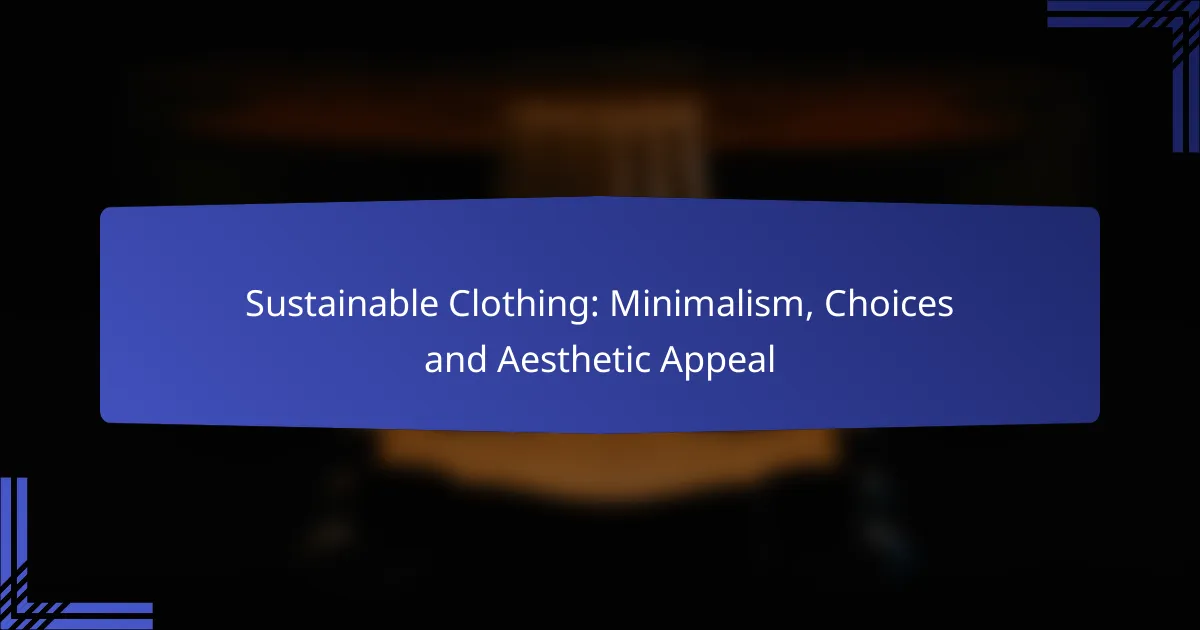Sustainable clothing embodies the principles of minimalism by encouraging a curated wardrobe that focuses on essential, high-quality pieces. This mindful approach not only lessens environmental impact but also simplifies personal style choices, allowing for a more cohesive aesthetic. By prioritizing eco-friendly materials and ethical production practices, consumers can make informed decisions that benefit both the planet and their wardrobe.

How can sustainable clothing enhance minimalism?
Sustainable clothing enhances minimalism by promoting a streamlined wardrobe that prioritizes essential pieces over excess. This approach not only reduces environmental impact but also simplifies daily choices, making it easier to maintain a cohesive style.
Reduction of clutter
By choosing sustainable clothing, individuals can significantly reduce wardrobe clutter. This involves selecting versatile items that can be mixed and matched, leading to fewer pieces overall. A well-curated collection of sustainable garments can create a more organized and visually appealing space.
Consider implementing a capsule wardrobe strategy, where you limit your clothing to a set number of items, typically between 20 to 40 pieces. This method encourages mindful purchasing and helps eliminate unnecessary duplicates.
Focus on quality over quantity
Sustainable clothing emphasizes quality materials and craftsmanship, which often results in longer-lasting garments. Investing in fewer, high-quality pieces can save money over time, as these items typically withstand wear and tear better than fast fashion alternatives.
When shopping, look for brands that prioritize ethical production practices and use durable fabrics. This not only supports sustainability but also ensures that each piece in your wardrobe serves a purpose and remains stylish for years.
Timeless designs
Timeless designs are a hallmark of sustainable clothing, as they transcend seasonal trends and promote longevity. By opting for classic styles, individuals can create a wardrobe that remains relevant, reducing the need for frequent updates.
Focus on neutral colors and simple silhouettes that can be easily accessorized or layered. This approach not only enhances versatility but also aligns with minimalist principles, allowing for a cohesive aesthetic without excess.

What are the best sustainable clothing brands in the US?
The best sustainable clothing brands in the US prioritize eco-friendly practices, ethical labor, and stylish designs. These brands often use organic materials, promote fair trade, and implement transparent supply chains to reduce their environmental impact.
Patagonia
Patagonia is renowned for its commitment to environmental sustainability and social responsibility. The brand uses recycled materials in many of its products and offers a repair program to extend the life of its clothing.
Additionally, Patagonia donates a percentage of its profits to environmental causes, reinforcing its mission to protect the planet. Their outdoor apparel is designed for durability, making it a practical choice for eco-conscious consumers.
Eileen Fisher
Eileen Fisher focuses on creating timeless, elegant clothing with a minimal environmental footprint. The brand emphasizes organic and renewable fibers, and it has a robust take-back program that encourages customers to return used garments for recycling or resale.
By prioritizing ethical labor practices and sustainability, Eileen Fisher appeals to consumers looking for high-quality, stylish options that align with their values. The brand’s commitment to transparency allows customers to make informed choices about their purchases.
Reformation
Reformation is a trendy brand that combines fashion with sustainability, using eco-friendly materials and practices. The company tracks its environmental impact and shares this information with consumers, making it easier to understand the benefits of their purchases.
With a focus on stylish designs and limited production runs, Reformation aims to reduce waste in the fashion industry. Their clothing is often made from sustainable fabrics like Tencel and recycled materials, appealing to those who want to look good while supporting ethical practices.

How to choose sustainable fabrics?
Choosing sustainable fabrics involves considering their environmental impact, production methods, and durability. Look for materials that are organic, biodegradable, or recycled to minimize harm to the planet while ensuring quality and longevity.
Organic cotton
Organic cotton is grown without synthetic pesticides or fertilizers, making it a more environmentally friendly option compared to conventional cotton. It typically uses less water and promotes healthier soil, which benefits local ecosystems.
When selecting organic cotton, check for certifications such as GOTS (Global Organic Textile Standard) to ensure that the fabric meets strict environmental and social criteria. This can help you avoid greenwashing and ensure your purchase supports sustainable practices.
Hemp
Hemp is one of the most sustainable fabrics available, requiring minimal water and no pesticides during cultivation. Its fast growth rate and deep roots help improve soil health, making it a regenerative choice for sustainable fashion.
Hemp fabric is known for its durability and breathability, making it suitable for various clothing items. When buying hemp products, look for blends with organic cotton or other natural fibers to enhance comfort and style.
Tencel
Tencel, made from sustainably sourced wood pulp, is produced in a closed-loop process that recycles water and solvents, minimizing waste. This fabric is biodegradable and has a soft, luxurious feel, making it popular in eco-friendly fashion.
When choosing Tencel, consider its moisture-wicking properties and breathability, which make it ideal for activewear and casual clothing. Look for brands that emphasize transparency in their sourcing and production methods to ensure your Tencel garments are truly sustainable.

What are the aesthetic benefits of sustainable clothing?
Sustainable clothing offers unique aesthetic benefits that enhance personal style while promoting environmental responsibility. By focusing on quality materials and ethical production, these garments often feature distinctive designs and timeless appeal.
Unique styles
Sustainable clothing brands frequently emphasize originality, resulting in unique styles that stand out in a crowded market. Many of these brands prioritize limited production runs, which means fewer people will own the same piece, enhancing individuality.
When choosing sustainable fashion, look for items that incorporate innovative designs or artisan craftsmanship. This can include hand-stitched details, upcycled materials, or culturally inspired patterns that reflect a story or heritage.
Natural color palettes
The use of natural dyes and organic materials in sustainable clothing often leads to beautiful, earthy color palettes. These colors tend to be softer and more muted compared to synthetic dyes, providing a calming aesthetic that can easily complement various wardrobes.
Consider incorporating shades like olive green, rust, or soft beige into your collection. These hues not only align with sustainable practices but also offer versatility, allowing for easy mixing and matching with other pieces.
Versatile pieces
Sustainable clothing often focuses on versatility, with designs that can be styled in multiple ways. This adaptability means that a single piece can serve various occasions, reducing the need for excessive purchases.
Look for items like a classic wrap dress or a tailored jacket that can transition from casual to formal settings. Investing in versatile pieces not only enhances your wardrobe but also supports a minimalist approach to fashion, aligning with sustainable principles.

How does sustainable clothing impact the environment?
Sustainable clothing significantly reduces environmental harm by minimizing resource consumption and pollution. This approach emphasizes eco-friendly materials, ethical production practices, and a focus on longevity, which collectively contribute to a healthier planet.
Reduced carbon footprint
Sustainable clothing often utilizes materials and processes that generate lower greenhouse gas emissions. For example, organic cotton and recycled fabrics typically require less energy to produce compared to conventional textiles.
Choosing brands that prioritize sustainability can lead to a reduction in your personal carbon footprint. Look for certifications like Global Organic Textile Standard (GOTS) or brands that openly share their carbon reduction strategies.
Less water usage
The fashion industry is notorious for its high water consumption, particularly in the production of cotton and synthetic fibers. Sustainable clothing brands often implement water-efficient practices, such as using rain-fed crops or recycling water in their manufacturing processes.
For instance, producing a single pair of jeans can require thousands of liters of water in traditional methods, while sustainable practices can cut this down significantly. Opting for brands that promote water conservation can help mitigate this issue.
Minimized waste
Sustainable clothing aims to minimize waste through various strategies, including using recycled materials and promoting circular fashion. Brands that adopt a zero-waste philosophy design garments that leave little to no fabric scraps during production.
Additionally, many sustainable brands encourage consumers to recycle or upcycle their clothing, extending the life cycle of garments. Consider supporting initiatives that offer take-back programs or repair services to further reduce textile waste.

What are the cost considerations for sustainable clothing?
Cost considerations for sustainable clothing often include higher upfront prices, potential long-term savings, and the value of durability. Understanding these factors can help consumers make informed choices that align with their budget and values.
Higher initial investment
Sustainable clothing typically requires a higher initial investment compared to fast fashion alternatives. This is due to the use of eco-friendly materials, ethical labor practices, and sustainable production methods. For example, a sustainably made shirt might cost 50-100% more than a similar item from a conventional retailer.
While the price tag may be daunting, it’s essential to consider the quality and ethical implications behind these costs. Investing in sustainable fashion supports responsible brands and promotes better working conditions for garment workers.
Long-term savings
Although sustainable clothing often comes with a higher price upfront, it can lead to long-term savings. Durable, high-quality garments tend to last longer, reducing the need for frequent replacements. This means fewer purchases over time, which can save consumers money in the long run.
Additionally, some sustainable brands offer repair services or lifetime guarantees, further extending the lifespan of the clothing. By choosing quality over quantity, consumers can minimize their overall spending on clothing.
Value of durability
The durability of sustainable clothing is a significant factor in its cost-effectiveness. These garments are designed to withstand wear and tear, often using robust materials that resist fading and damage. This durability not only enhances the lifespan of the clothing but also contributes to a more sustainable wardrobe.
When evaluating clothing options, consider the cost per wear. A higher-priced, durable item that lasts for years can be more economical than cheaper, lower-quality pieces that need to be replaced frequently. Prioritizing durability helps reduce waste and supports a more sustainable lifestyle.
